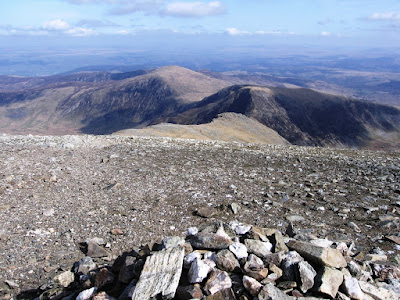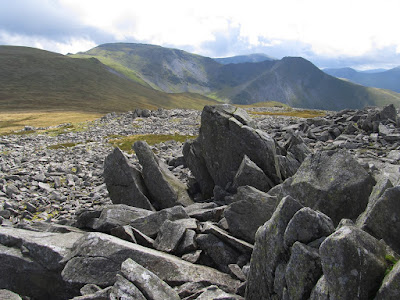If the path beside the stream was better this would be a grand way up along a great ridge that steadily climbs with precipitous drops into Cwm Lloer on your right. It is a shame that despite three ascents by this route I don’t have any good pictures of the climb up this great ridge that leads all the way up to the summit of Pen Yr Ole Wen. In 2006 I descended straight down to Idwal Cottage from the top and I remember it being an awesome, relentless scramble that destroyed my knees for weeks following. I would love to attempt the challenge of the south ridge as an ascent, but good weather would be essential as it is an accident hotspot. A much easier and gentler route up is the one that I took as a descent in 2015 down the grassy slopes of the north west ridge of Braich Ty Du, but while this definitely works as a descent it would be very dull as an ascent. Attention at this point should be on the main Carneddau ridge that starts on Pen Yr Ole Wen and sets off around the top of Cwm Lloer gradually rising to the large cairn that sits at the summit of Carnedd Dafydd. This is truly a great mountain with rock in abundance everywhere and impressive cliffs that fall spectacularly down the northern faces.
In 2007 I climbed these northern slopes on Crib Lem, a ridge that separates Cwmglas Bach and Cwmglas Mawr, requiring a scramble that is not too difficult even for someone like me. It is a grand way up a mountain, but if you prefer your climbs considerably more gentle then the slopes of Mynydd Du on the north-west ridge would be better, but for me this is better as a descent so I took this route down in 2005. The main ridge continues above the precipitous cliffs of Ysgolion Duon for an excellent walk across a saddle that doesn’t drop below three thousand feet before climbing up to the top of the highest point in the Carneddau, Carnedd Llewelyn. A great ridge heads off east from the summit before turning south narrowing deliciously along Bwlch Eryl Farchog before rising steeply to Pen yr Helgi Du. This was my route off the main Carneddau ridge in 2003 and again when I repeated the walk in 2009 and 2019. A round of the two main peaks of the Carneddau with Pen Yr Ole Wen and Pen yr Helgi Du must be the best mountain walk in the range and is why I have done it three times. It is great in any weather and I endured some terrible weather on the round in 2009, but I still enjoyed it as these mountains are too great to be ruined by a bit of bad weather.
On the other side of Carnedd Llewelyn is its companion, the shapely Yr Elen that is connected to its parent by a narrow ridge. In 2007 I descended from the top down the broad grassy slopes of Braich y Brysgyll, but for an ascent I prefer something steep and the north-eastern ridge provided me with a glorious route up in 2015. In 2003 and 2006 I visited Yr Elen as a diversion from the main ridge returning to Carnedd Llewelyn to continue along the main ridge, but this unfairly relegates a fine mountain to a supporting role tagged onto its bigger parent. This is not fair as it deserves to be climbed for its own sake and not simply to tick a box in a list of mountain tops. Resuming the walk along the main Carneddau ridge a long descent down the slopes of Carnedd Llewelyn takes us to the grass saddle of Gwaun y Garnedd before rising again to the top of Foel Grach. Just beyond the summit is a small refuge hut that was very welcome on my walk in the area in 2003 as it provided me with shelter from heavy rain and gave me somewhere dry to sit while I had my lunch. Grassy slopes continue the descent and now for the first time the ridge drops below three thousand feet, but it isn’t long before the gradient rises again to a peak whose fortunes has improved considerably.
At one time Garnedd Uchaf was not considered to be more than three thousand feet high, but then a re-survey revealed that it was, although it is still the smallest in the Carneddau. The first couple of times I visited it I had difficulty finding the top because of low cloud and a low prominence, until eventually in 2006 I had good weather and was able to appreciate the great views across to Yr Elen and Carnedd Llewelyn. Since then the top has been officially renamed Carnedd Gwenllian to tie in with the historical connection of the names of the other peaks, but I will always remember it as being Garnedd Uchaf. At this point the ridge splits in two descending west over Bera Bach and Drosgl on a ridge that I have climbed a few times, twice (in 2003 and in 2015) climbing onto the ridge from the nature reserve to the north and once (in 2005) from Bethesda to the west. Despite long grassy slopes it is a convenient route up to the Carneddau ridge. East of Garnedd Uchaf the ridge crosses a boggy saddle before rising one more time to reach the summit of Foel-fras, the last three thousand footer in the Carneddau
The terrain beyond Foel-fras is broad and grassy with much less rock and less of the mountainous feel as the ridge descends over Drum, also known as Carnedd Penyborth-Goch, gradually descending all the way to the coast. I came down this ridge in 2003 and it makes a great descent with far reaching views out to sea. In 2006 I got off a train at the station in Llanfairfechan and walked from the coast all the way into these great mountains on an epic walk that took in all seven peaks in the Carneddau in one single day. This is the only time I have reached them all in one day as usually I do the northern peaks separately from the highest peaks, for example, as I did in 2003. Although the whole range is an awesome series of mountains it is really the two highest mountains, Carnedd Llewelyn and Carnedd Dafydd, and those near them that deserve the accolade of being Great Mountains. In that area rock abounds with sheer cliffs, narrow ridges and great views that are enough to hail these mountains with ultimate praise.










